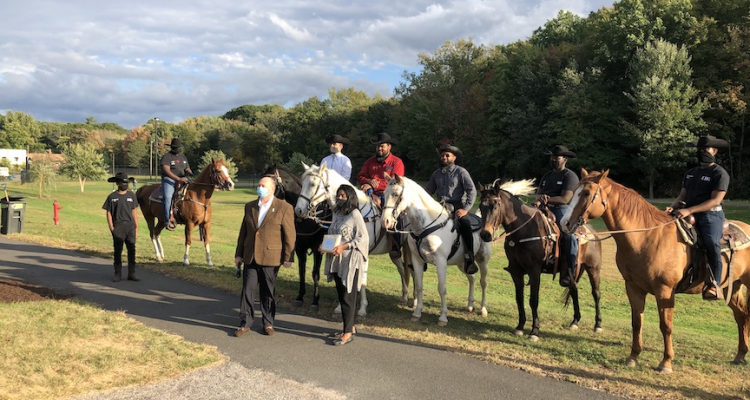Patricia Kelly was just nine years old when her family moved to Hartford in 1955. The move was a tough one for Kelly, who was subjected to racist taunts from the neighborhood children. All that changed when she discovered there was a horse in her urban neighborhood. It was owned by one of her neighbors.
“His name was Mr. Fisher. And Mr. Fisher was concerned about me being young and hearing the kind of things that were going on in the front of my house. Mr. Fisher handed me a brush [one day] and I fell in love with the horse. I stayed with Mr. Fisher for about three years, living right next door to me,” Kelly, now 74 years old, said in an interview.
Because she had learned at a young age the power horses can have over people, she founded Ebony Horsewomen in 1984, an organization aimed at empowering Black women through equine-assisted psychotherapy. The organization’s home is at Keney Park in Hartford. Ileana Sullivan, an administrative assistant at the nonprofit, said Ebony Horsewomen serves about 50 clients a week from Greater Hartford and New Haven.
Ebony Horsewomen is just one organization focused on equine-assisted services, which encompasses occupational therapy, speech therapy, psychotherapy, physical therapy and therapeutic riding. There are at least 20 equine-assisted service programs in Connecticut, according to 211ct and the Equine Assisted Growth and Learning Association (EAGALA)’s website.
Research shows that equine-assisted services offer emotional and physical benefits. For example, a 2018 systemic review of equine therapy studies on people with autism in the Review Journal of Autism and Developmental Disorders found that horse therapy decreased irritability, hyperactivity and sensory sensitivity.
Horses have several characteristics that make them suited for therapy. For example, a horse can sense a human’s emotions. Kelly said, for example, horses can implicitly sense lies through changes like a person’s heartbeat and body language. In turn, those reactions can help the client peel back the layers of their trauma.
Even the horse’s own trauma can promote healing, Kelly said. Clients may identify with and choose a particular horse for the therapy sessions. This kind of connection can lead to increased growth, as the client uncovers more about themselves because of the kinship they develop with the horse.
One of the first activities that a therapist might do is introduce a group of clients to a herd of horses, according to Kitty Stalsburg, executive director of High Hopes Therapeutic Riding in Old Lyme and a therapeutic riding instructor at the organization.
“When that horse either greets them or not, [the therapist] can use that interaction as a talking point. For example, you went up to that horse with a tough person attitude and said, ‘I’m going to put this halter on you.’ And that horse turned its butt and walked away,” Stalsburg said. “And they’ll talk about how else you could have done that. Could you have gone up without having made eye contact?”
High Hopes, which was founded in 1974, utilizes equine-assisted services like occupational therapy and therapeutic riding, according to the High Hopes website. Stalsburg said High Hopes’ programs served more than 1,000 unique riders in 2021, mainly in the areas of New London, Norwich, New Haven and Hartford. Therapeutic riding sessions there cost $1,705 per year, but they also offer financial aid.
Judith Cohen, a High Hopes senior rider and volunteer who has been riding since 2010, said riding has been good for her joints and ability to be mindful.
“You have to be with all the horses in the moment and it’s like a vacation, because people tend to overthink things. Much of what I have gained from this also comes from my hard work on communicating and connecting with the horse,” Cohen said. “And the physical gains have been immeasurable. I’ve had joint replacements and it’s been good about it. When I ride, I can gauge where I need to put more effort in. My instructors also point out when I’m not using my body evenly.”

A horse named Arthur from High Horse Therapeutic Riding, per their website.
Equine therapy isn’t just for those who are physically fit. Dr. Jenifer Nadeau, an Associate Professor at the University of Connecticut, and the creator of the Therapeutic Horsemanship minor, said she saw a girl at High Hopes who was “daring on the saddle,” but had trouble walking. Nadeau said that riding made the girl feel like she didn’t have a disability.
Nadeau also talked about the accommodations that can be made for those with disabilities. A mounting block, which is a big ramp, can be placed near the horse to help certain riders mount. Someone in a wheelchair could be lifted onto the horse.
“[The rider] might go over to a basketball hoop on the horse and shoot basketballs to practice hand eye coordination or have to reach for a ring. They might go over obstacles and steer through them,” Nadeau said. “Some riders will need someone to walk next to them. Sometimes, you have to have a stabilizing hold on the rider, like one arm over their leg or back for support.”
Kelly said there are special benefits to equine therapy for people of color.
“Conversations [between a white therapist and a Black client] could end up with having their children taken away. On top of that, in the early years of therapy, Black women who were assertive were often called crazy,” Kelly said. “Being crazy could get you locked up where you would be subjected to shock treatments, lobotomies and a bunch of other torture-like conditions. So, the notion of therapy and the notion of talking to anybody white, about issues, was a dangerous situation. Equine-assisted psychotherapy is a modality where there is really no need to talk.”
To combat mistrust, Ebony Horsewomen tailors therapy to those with different cultural backgrounds and is the only organization in Connecticut to offer Culturally Competent Equine Assisted Psychotherapy, according to the Ebony Horsewomen website. Their sessions cost $180 per hour. Medicare and most private insurances are accepted.
“The therapists who are trained in Equine Assisted Psychotherapy understand horse psychology and behavior. Subtle gestures of a horse like the distance between you and the horse is a diagnostic apparatus for the therapist,” Kelly said. “A lot of people feel that it is safe and comfortable to talk to the horse, as opposed to talking to the therapists. If you understand the goal of therapy, the goal of therapy is to get the individual to understand what their triggers are, what their stressors are and what their trauma is. And the therapist is there to provide tools to help them manage it.”
This is an article that was originally written in 2022, but was not published at the time of writing.


